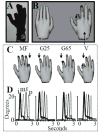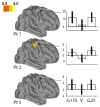Visuomotor discordance during visually-guided hand movement in virtual reality modulates sensorimotor cortical activity in healthy and hemiparetic subjects
- PMID: 23314780
- PMCID: PMC3762883
- DOI: 10.1109/TNSRE.2013.2238250
Visuomotor discordance during visually-guided hand movement in virtual reality modulates sensorimotor cortical activity in healthy and hemiparetic subjects
Abstract
We investigated neural effects of visuomotor discordances during visually-guided finger movements. A functional magnetic resonance imaging (fMRI)-compatible data glove was used to actuate (in real-time) virtual hand models shown on a display in first person perspective. In Experiment 1, we manipulated virtual hand motion to simulate either hypometric or unintentional (actuation of a mismatched finger) feedback of sequential finger flexion in healthy subjects. Analysis of finger motion revealed no significant differences in movement behavior across conditions, suggesting that between-condition differences in brain activity could only be attributed to varying modes of visual feedback rather than motor output. Hypometric feedback and mismatched finger feedback (relative to veridical) were associated with distinct activation. Hypometric feedback was associated with activation in the contralateral motor cortex. Mismatched feedback was associated with activation in bilateral ventral premotor, left dorsal premotor, and left occipitotemporal cortex. The time it took the subject to evaluate visuomotor discordance was positively correlated with activation in bilateral supplementary motor area, bilateral insula, right postcentral gyrus, bilateral dorsal premotor areas, and bilateral posterior parietal lobe. In Experiment 2, we investigated the effects of hypo- and hypermetric visual feedback in three stroke subjects. We observed increased activation of ipsilesional motor cortex in both hypometric and hypermetric feedback conditions. Our data indicate that manipulation of visual feedback of one's own hand movement may be used to facilitate activity in select brain networks. We suggest that these effects can be exploited in neurorehabilition to enhance the processes of brain reorganization after injury and, specifically, might be useful in aiding recovery of hand function in patients during virtual reality-based training.
Figures






Similar articles
-
Mirrored feedback in chronic stroke: recruitment and effective connectivity of ipsilesional sensorimotor networks.Neurorehabil Neural Repair. 2014 May;28(4):344-54. doi: 10.1177/1545968313513074. Epub 2013 Dec 26. Neurorehabil Neural Repair. 2014. PMID: 24370569 Free PMC article.
-
Visuomotor gain distortion alters online motor performance and enhances primary motor cortex excitability in patients with stroke.Neuromodulation. 2012 Jul;15(4):361-6. doi: 10.1111/j.1525-1403.2012.00467.x. Epub 2012 Jun 1. Neuromodulation. 2012. PMID: 22672345 Free PMC article.
-
Network interactions underlying mirror feedback in stroke: A dynamic causal modeling study.Neuroimage Clin. 2016 Nov 21;13:46-54. doi: 10.1016/j.nicl.2016.11.012. eCollection 2017. Neuroimage Clin. 2016. PMID: 27920978 Free PMC article.
-
Integrated technology for evaluation of brain function and neural plasticity.Phys Med Rehabil Clin N Am. 2004 Feb;15(1):263-306. doi: 10.1016/s1047-9651(03)00124-4. Phys Med Rehabil Clin N Am. 2004. PMID: 15029909 Review.
-
Using virtual reality to augment perception, enhance sensorimotor adaptation, and change our minds.Front Syst Neurosci. 2014 Apr 8;8:56. doi: 10.3389/fnsys.2014.00056. eCollection 2014. Front Syst Neurosci. 2014. PMID: 24782724 Free PMC article. Review.
Cited by
-
Learning and transfer of complex motor skills in virtual reality: a perspective review.J Neuroeng Rehabil. 2019 Oct 18;16(1):121. doi: 10.1186/s12984-019-0587-8. J Neuroeng Rehabil. 2019. PMID: 31627755 Free PMC article. Review.
-
Virtual reality combined with task-oriented circuit training for upper limb rehabilitation in subacute stroke patients: A randomized controlled trial.Medicine (Baltimore). 2025 Aug 1;104(31):e43505. doi: 10.1097/MD.0000000000043505. Medicine (Baltimore). 2025. PMID: 40760546 Free PMC article. Clinical Trial.
-
Can motion capture improve task-based fMRI studies of motor function post-stroke? A systematic review.J Neuroeng Rehabil. 2025 Apr 3;22(1):70. doi: 10.1186/s12984-025-01611-1. J Neuroeng Rehabil. 2025. PMID: 40181338 Free PMC article.
-
Mirrored feedback in chronic stroke: recruitment and effective connectivity of ipsilesional sensorimotor networks.Neurorehabil Neural Repair. 2014 May;28(4):344-54. doi: 10.1177/1545968313513074. Epub 2013 Dec 26. Neurorehabil Neural Repair. 2014. PMID: 24370569 Free PMC article.
-
Virtual reality interface devices in the reorganization of neural networks in the brain of patients with neurological diseases.Neural Regen Res. 2014 Apr 15;9(8):888-96. doi: 10.4103/1673-5374.131612. Neural Regen Res. 2014. PMID: 25206907 Free PMC article.
References
-
- Wise SP, et al. Changes in motor cortical activity during visuomotor adaptation. Exp Brain Res. 1998 Aug;121:285–99. - PubMed
-
- Patuzzo S, et al. Modulation of motor cortex excitability in the left hemisphere during action observation: a single- and paired-pulse transcranial magnetic stimulation study of self- and non-self-action observation. Neuropsychologia. 2003;41:1272–8. - PubMed
-
- Mattar AA, Gribble PL. Motor learning by observing. Neuron. 2005 Apr 7;46:153–60. - PubMed
-
- Patton JL, et al. Evaluation of robotic training forces that either enhance or reduce error in chronic hemiparetic stroke survivors. Exp Brain Res. 2006 Jan;168:368–83. - PubMed
Publication types
MeSH terms
Grants and funding
LinkOut - more resources
Full Text Sources
Other Literature Sources
Medical

